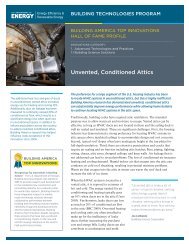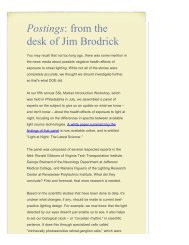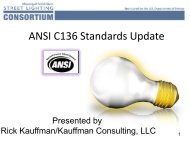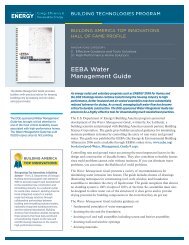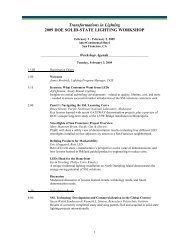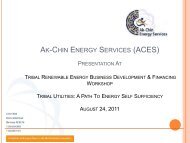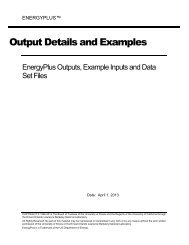EnergyPlus Interface Developer's Guide - EERE - U.S. Department ...
EnergyPlus Interface Developer's Guide - EERE - U.S. Department ...
EnergyPlus Interface Developer's Guide - EERE - U.S. Department ...
Create successful ePaper yourself
Turn your PDF publications into a flip-book with our unique Google optimized e-Paper software.
Input Details IDD Conventions<br />
!<br />
! \extensible: This object is dynamically extensible -- meaning, if you<br />
! change the IDD appropriately (if the object has a simple list<br />
! structure -- just add items to the list arguments (i.e. BRANCH<br />
! LIST). These will be automatically redimensioned and used during<br />
! the simulation. should be entered by the developer to signify<br />
! how many of the last fields are needed to be extended (and <strong>EnergyPlus</strong><br />
! will attempt to auto-extend the object). The first field of the first<br />
! instance of the extensible field set is marked with \begin-extensible.<br />
!<br />
! \begin-extensible See previous item, marks beginning of extensible fields in<br />
! an object.<br />
!<br />
! \format The object should have a special format when saved in<br />
! the IDF Editor with the special format option enabled.<br />
! The options include SingleLine, Vertices, CompactSchedule,<br />
! FluidProperties, ViewFactors, and Spectral.<br />
! The SingleLine option puts all the fields for the object<br />
! on a single line. The Vertices option is used in objects<br />
! that use X, Y and Z fields to format those three fields<br />
! on a single line.<br />
! The CompactSchedule formats that specific object.<br />
! The FluidProperty option formats long lists of fluid<br />
! properties to ten values per line.<br />
! The ViewFactor option formats three fields related to<br />
! view factors per line.<br />
! The Spectral option formats the four fields related to<br />
! window glass spectral data per line.<br />
!<br />
! \reference-class-name Adds the name of the class to the reference list<br />
! similar to \reference.<br />
!<br />
! Group-level comments:<br />
!<br />
! \group Name for a group of related objects<br />
!<br />
!<br />
! Notes on comments<br />
! -----------------<br />
!<br />
! 1. If a particular comment is not applicable (such as units, or default)<br />
! then simply omit the comment rather than indicating N/A.<br />
!<br />
! 2. Memos and notes should be brief (recommend 5 lines or less per block).<br />
! More extensive explanations are expected to be in the user documentation<br />
IDD – IP Units<br />
In addition, the IDD contains indications of IP (inch-pound) units for the <strong>EnergyPlus</strong> standard<br />
SI (Systems International) units. These may be used by input and output interfaces to display<br />
values in the IP system. As noted, if the IP units are “standard” (first block below), then no \ipunits<br />
is expected in the field. Note that for some fields – due to their multiple use (for<br />
example, schedule values) – there cannot be a ip-unit designation.<br />
! Default IP conversions (no \ip-units necessary)<br />
! $/(m3/s) => $/(ft3/min) 0.000472000059660808<br />
! $/(W/K) => $/(Btu/h-F) 0.52667614683731<br />
! $/kW => $/(kBtuh/h) 0.293083235638921<br />
! $/m2 => $/ft2 0.0928939733269818<br />
! $/m3 => $/ft3 0.0283127014102352<br />
! (kg/s)/W => (lbm/sec)/(Btu/hr) 0.646078115385742<br />
! 1/K => 1/F 0.555555555555556<br />
! 1/m => 1/ft 0.3048<br />
4/1/13 10





